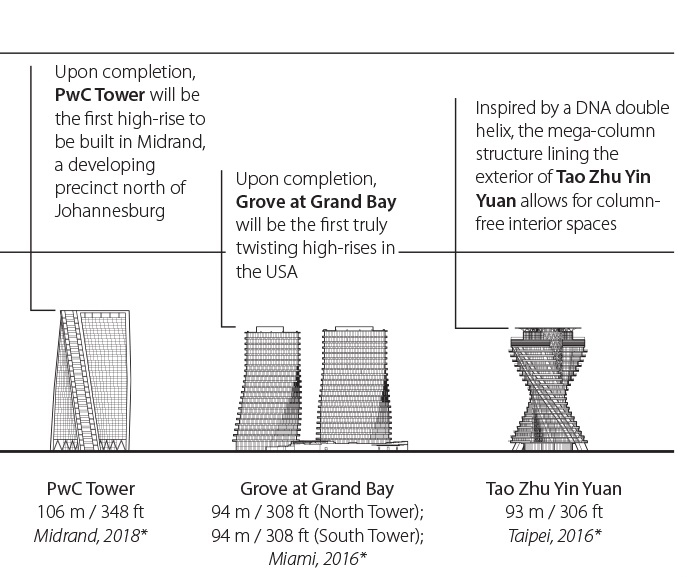Twisting buildings
In August 2016, the Council on Tall Buildings and Urban Habitat (CTBUH) published a new study, Twisting Tall Buildings, examining the recent proliferation of spiralling towers being developed around the world.
The report defines a building as ‘twisting’ if it progressively rotates its floor plates or its façade as it gains height. It is usual that each plate will be similarly shaped in plan, and turned on a shared axis a consistent number of degrees from the preceding floor.
Not only are these ‘twisters’ often aerodynamic and energy-efficient as a result of their design, they are able to incorporate a wide variety of textures, view angles and ripple effects.
The report identifies 28 twisting towers that are either complete or under construction. This is evidence, the report says, of a growing trend in this new type of structure.
 At 632 m (2,073 ft) tall, the Shanghai Tower is currently (2016) the second tallest building in the world.
At 632 m (2,073 ft) tall, the Shanghai Tower is currently (2016) the second tallest building in the world.
The Diamond Tower in Jeddah, scheduled for completion in 2019, will be the world’s second tallest twisting tower, and the only building to twist a full 360-degrees along its height.
F&F Tower, Panama City, holds the record for the ‘tightest’ twist, that is, the greatest average rotation per floor, at 5.943-degrees across each of its 53 floors.
CTBUH is the world’s leading resource for professionals focused on the inception, design, construction, and operation of tall buildings and future cities.
Images and content courtesy of CTBUH.
[edit] Related articles on Designing Buildings Wiki
Featured articles and news
British Architectural Sculpture 1851-1951
A rich heritage of decorative and figurative sculpture. Book review.
A programme to tackle the lack of diversity.
Independent Building Control review panel
Five members of the newly established, Grenfell Tower Inquiry recommended, panel appointed.
Welsh Recharging Electrical Skills Charter progresses
ECA progressing on the ‘asks’ of the Recharging Electrical Skills Charter at the Senedd in Wales.
A brief history from 1890s to 2020s.
CIOB and CORBON combine forces
To elevate professional standards in Nigeria’s construction industry.
Amendment to the GB Energy Bill welcomed by ECA
Move prevents nationally-owned energy company from investing in solar panels produced by modern slavery.
Gregor Harvie argues that AI is state-sanctioned theft of IP.
Heat pumps, vehicle chargers and heating appliances must be sold with smart functionality.
Experimental AI housing target help for councils
Experimental AI could help councils meet housing targets by digitising records.
New-style degrees set for reformed ARB accreditation
Following the ARB Tomorrow's Architects competency outcomes for Architects.
BSRIA Occupant Wellbeing survey BOW
Occupant satisfaction and wellbeing tool inc. physical environment, indoor facilities, functionality and accessibility.
Preserving, waterproofing and decorating buildings.






















